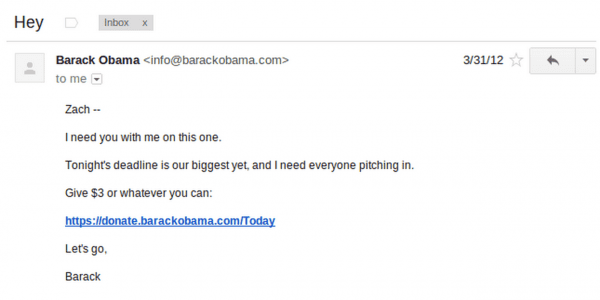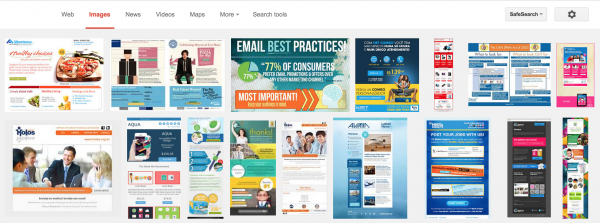We have written a great deal about the myriad WordPress plugins and services you can use to create your email marketing campaigns here on the Elegant Themes blog over the years.
However, we haven’t yet had a great deal to say about how to use the above-mentioned tools to create effective emails. A couple of commenters pointed this out in our MailPoet review, which provided us with the ideal prompt to redress our oversight.
With the above said, in this post we are going to dissect the key elements of effective email marketing messages and show you how to craft emails that engage and convert.
How to Craft Compelling Subject Lines
Your subject line is arguably the most important part of any email you send. Its efficacy ultimately determines how many people read your email and take action.
You probably appreciate this in principle, but I’m willing to bet that you don’t embrace it in practice. By ’embracing’ it, I mean that you should arguably be spending as much time (if not more) optimizing your subject line as you do writing the remainder of the email.
As MailChimp points out, the best subject lines tend to be short, descriptive, and give your subscriber a reason to open your email and read more. A simple formula in theory, but not so easy to execute in practice.
Generic subject lines tend to fare poorly, so put some personality into your subject to give your message more life. Up to around 50 characters is a good length, though some great subject lines can be longer and some shorter.
Finally, consider composing your subject headline like you’re only writing to a single friend. Familiarity works. Many of Hubspot’s top 18 subject lines observe this rule, including perhaps the most successful email subject line in recent memory, Barack Obama’s “Hey”:
That overly familiar subject line, use of first name and the very familiar sign off helped get millions of opens and millions in online campaign donations.
How to Draw Readers in With Your Sender Name
Speaking of your sender name, take upmost care of how you word this. Even though you’re not the President of the United States running for reelection, you can still make your email stand out with a well-planned “sender” line.
The key here is to be clear about who is sending the message and use the same moniker for each message. This part of your email helps your audience pick your message out of a list by creating familiarity. Once the reader has opened and gotten value from one or two of your messages, they’ll be more likely to open a third that uses the same naming format.
However, one exception to this is if you want to make your email stand out with humorous or ostentatious sender name. Chubbies, a mens apparel company, has been called a “Gen Y media company that happens to sell shorts”. It certainly stands out when I see emails from “Chubbicus Maximus” or “Warren Chubbett” in my inbox – both real examples.
How to Write a Better Email Snippet
Your email snippet or preview is another place to get creative. Usually, this is the tiny text at the top of an email telling the reader they can click to view a web version of the email message. While that option may be valuable for some, this usually isn’t the best use of what can be valuable real estate.
That’s because this text is often displayed as a preview of the message content in certain email clients. For that reason, your email’s snippet can find a better use than linking to the web version of the message. Edit the default preview snippet text in your email marketing app or plugin to take advantage of this message space. MailChimp, AWeber, MailPoet and others let you customize this text.
Consider this text a follow-up to your subject line. Ask yourself how you can support and expand on that subject idea, to give your reader yet another reason to click to open and read your email message.
I like a few of the ideas that iMediaConnection suggests for snippets:
- For a sales message: Rephrase your offer of a discounted price, free shipping, or something else mentioned in your subject line.
- For a newsletter: Tease your reader with a headline or interesting detail from within your message.
- For a confirmation email: Confirm the user’s action or offer thanks, where appropriate.
Once your subscriber clicks to open your email, you need to deliver on whatever promise you made or interest you sparked with your subject line and snippet. Keep your message focused and don’t try to cover too many topics.
For example, it would be too much to mention a discount, a new product announcement and a blog post from the CEO all in one email. Each of those could be an individual email that better targets subscribers and your marketing goals. However, you can certainly send a newsletter that has multiple blog updates on various topics. Despite the variety, this content would serve to inform readers only about your blog updates – a single topic.
How to Pick the Best Layout for Your Content
For the layout of your message, consider these tips:
- Use a layout that works for both desktop and mobile recipients.
- Put the most important information first.
- Don’t get too wordy with copy.
- Use relevant, engaging and value-adding imagery.
You must also carefully consider the style of your email:
- Will you use a one-, two- or three-column design?
- Will you focus on a big headline and striking imagery, or a more ‘casual’ plain email format?
Don’t be afraid to look around for inspiration. There are myriad examples of effective email marketing messages out there. Hubspot has a nice roundup of examples, and a Google Image Search for “email marketing layout” will give you even more examples to draw inspiration from:
Also, don’t forget to check out what template options your email marketing app or plugin offers. Templates are highly customizable and, with a little work, you can make a standard layout feel completely original – without coming up with a design from scratch.
Lastly, after you’ve made a layout for a particular type of message – newsletter, sales message, etc. – save it and reuse it. This will save you a great deal of time that you can spend on other parts of your email marketing.
How to Fill in Your Message with Content
Now that you’ve decided on a basic layout for your email marketing efforts, you need content to fill it. Consider an email much like you would a web page: There’s a header area, body content area, and footer area. Imagery will also be a major component.
Images
Let’s start with images. They say a picture is worth a 1,000 words, but email clients tell users to “click to load images”. You’ll definitely want to include imagery in your email message, but take care that you don’t rely too heavily on visuals that may not display for all users. Fill in alternate image text where possible and make sure you have pure text areas of the message that identify the its content.
Header
Your brand name and other top-level info should go in your message’s header area. Larger typefaces are typical and you can add imagery here for added impact. Some marketers go with a brand’s logo image, but be aware that this may be obscured initially for some recipients.
Body
The body of your email is the heart of your marketing campaign’s message. Be clear about your goals before you create this content. Do you want to:
- Inform the reader about a retail offer?
- Update the reader on new site content?
- Send a response, confirmation, or acknowledgement?
Whatever your purpose, your answer will influence how your body content is shaped.
If you have a discount special or new product, you’ll need to include appropriate imagery and important details. If you have new site content, you’ll need to include excerpts and a feature image.
Also think about how many items are being covered. For just one or two offers or updates, you can afford to give more room for text. For a longer list of products or blog post updates, mid-sized headlines and an accompanying image will work well.
Lastly, think about how you can use typography to make your email easier to skim over:
- Make a new paragraph to set important statements apart.
- Use text size to create a hierarchy of importance.
- Use bold, underline, or italics to draw attention to important words and phrases.
- Use standard underline and bold formatting to identify your links.
It’s also worth considering what parts of the message will stay the same for each campaign message. Your footer is a great candidate when it comes to recycling content. You’ll likely have a link to unsubscribe, your address, hours of operation, sponsor or partner logos, small-print disclaimers, and other such business info in the footer. Design this section once and reuse it to make your work easier and your subscribers’ experience more consistent.
Wrapping Up
Much like writing a blog post or designing a web page, putting together an effective email marketing message gets easier with practice. Take time to get the wording and focus just right for your email subject line, sender name, and snippet to increase your open and click-through rates. Save yourself time on new marketing campaigns by reusing templates and even some content, such as footer content.
Lastly, go looking for inspiration and new ideas. Do a search every so often for email marketing examples and make note of any ideas you really love. Sign up for more email newsletters as well. Choose peer newsletters, competitors, industry leaders and more to get a broad idea of what types of email marketing are popular for others in your niche.
What tips do you have when it comes to creating a new email marketing campaign? Let us know in the comments below!
Image Credit: Aniwhite / ShutterStock












Thank you Tom, your article is most interesting and insightful. It is my endeavour to implement the nuggets I have gained here into my email marketing.
To your continued success!!
Dodrey
Hi Tom,
Excellent tips and a great blog post discussing the various components of an effective email.
I make it a point to read the different blog posts published at ET as most of them are very informative.
Keep up the good work!
Raj
Hi Tom,
Excellent points, Tom. It’s difficult to add anything useful to such a well thought out entry.
It’s sad that many persons – bloggers and info marketers inclusive – sadly neglect all the clearly awesome tips shared here right after reading…it is sad too that success with a list cannot be got any inch from deviating from this blueprint.
Do enjoy the day!
Always,
Akaahan Terungwa
Great points about copywriting. I love the blog articles Elegant Themes puts out, always something interesting & relevant.
Great tips. I get most of my website traffic from email newsletters so this is great.
That was seriously an Obama campaign email? I voted for him, but now I’m sorry I did. That is horrible, no matter how much money it made him. People are suckers. I guess I was a sucker just for voting for him, too.
@Tim…. funny. With the example used in this post, it will be impossible to focus on the point and not the politics. I am skeptical of any “grass roots”, “I am your buddy” approaches. They are phony. When there is no substance behind the message, you get what you get… nothing.
Well, I’ve learned my lesson. I’m not voting in the next election because there is absolutely NO ONE that I have any confidence in running this time. I challenge everyone in the U.S. to really “rock the vote” and NOT vote.
Not voting is the absolute worst thing that you could do. People neglecting to vote is a large part of the problem!
NOW you’re sorry you did?? Glad that email was all it took to open your eyes and not the $10,000,000,000,000 in new national debt or 45,000,000 American’s on Food Stamps.